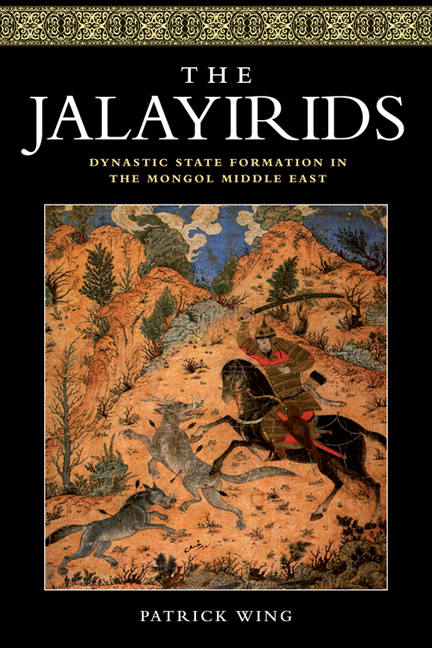Book contents
- Frontmatter
- Contents
- List of Illustrations
- Acknowledgements
- Abbreviations for Primary and Secondary Source Texts
- 1 Introduction and Sources for the History of the Jalayirids
- 2 Tribes and the Chinggisid Empire
- 3 The Jalayirs and the Early Ilkhanate
- 4 From Tribal Amirs to Royal In-laws
- 5 Crisis and Transition (1335–56)
- 6 Shaykh Uvays and the Jalayirid Dynasty
- 7 Dynastic Ideology during the Reign of Shaykh Uvays
- 8 Challenges to the Jalayirid Order
- 9 Conclusions and the Legacy of the Jalayirids
- Maps and Genealogical Chart
- Bibliography
- Index
5 - Crisis and Transition (1335–56)
- Frontmatter
- Contents
- List of Illustrations
- Acknowledgements
- Abbreviations for Primary and Secondary Source Texts
- 1 Introduction and Sources for the History of the Jalayirids
- 2 Tribes and the Chinggisid Empire
- 3 The Jalayirs and the Early Ilkhanate
- 4 From Tribal Amirs to Royal In-laws
- 5 Crisis and Transition (1335–56)
- 6 Shaykh Uvays and the Jalayirid Dynasty
- 7 Dynastic Ideology during the Reign of Shaykh Uvays
- 8 Challenges to the Jalayirid Order
- 9 Conclusions and the Legacy of the Jalayirids
- Maps and Genealogical Chart
- Bibliography
- Index
Summary
When Abū Sa‘īd Bahādur Khan died on 13 Rabī’ II 736/30 November 1335, in the words of Ḥāfiẓ Abrū, ‘the kingdom without a sultan became like a body without a soul and a flock without a shepherd’. With no clear heir to the throne, the Ilkhanid political order broke down. This had been an order based on the royal leadership of the Chinggisid dynasty descended from Hülegü, which by 1295 had settled in the line of Abaqa Khan. The centralising tendency that gained traction with Ghazan Khan and had reached its height under Abū Sa‘īd had created strong ties between the Ilkhanid royal house and other military grandees, such as Shaykh Ḥasan, as well as administrative families such as that of Rashīd al-Dīn and Ghiyāth al-Dīn Muḥammad. The death of Abū Sa‘īd put an end to the centralising dynamic of Ilkhanid politics. The period after 1335 was characterised by multiple power centres throughout the former Ilkhanid lands. An aspect of this development was the rise in power of the Oyrats, one of the few Mongolian tribes that still maintained its cohesion within the Ilkhanate in the fourteenth century. Although the Oyrats were initially led by their chief who attempted to take power after Abū Sa‘īd's death, Shaykh Ḥasan ultimately became the lord of the Oyrat territories in Diyarbakr and northern Iraq. In this sense, Shaykh Ḥasan was a tribal chief; however, it was not the Jalayir, but the Oyrat tribe that came under his command in the 1340s. By the time of Shaykh Ḥasan's death in 1356, he was only one of several regional rulers, in control of the region from Khuzistan in the south to Diyarbakr in the north. However, he was unable to capture the real prize, which was Azarbayjan and its capital Tabriz.
This was also a period in which the notion of Chinggisid sovereignty seems to have lost some of its significance. Until the 1340s, amirs who attempted to claim the Ilkhanate for themselves generally offered their services to a Chinggisid puppet, who served to legitimise their bid for power. After the 1340s, however, local rulers had largely dispensed with Chinggisid pretenders and attempted to construct alternative ideological narratives.
- Type
- Chapter
- Information
- The JalayiridsDynastic State Formation in the Mongol Middle East, pp. 74 - 100Publisher: Edinburgh University PressPrint publication year: 2016



